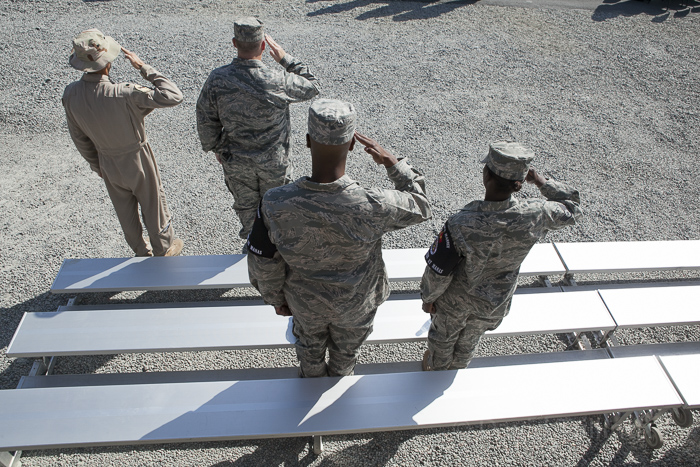The issue: American opinions about war have become more partisan in recent years, academics have found, as war and combat deaths remain salient foreign policy issues for voters. During the 2004 and 2008 U.S. presidential elections, war casualties helped Democrats garner votes. Meanwhile, researchers have shown the fear of losing office affects politicians’ foreign policy decisions. A new paper tries to measure the impact of war at the polls.
An academic study worth reading: “Death and Turnout: The Human Costs of War and Voter Participation in Democracies,” published by the American Journal of Political Science, 2016.
Study summary: Michael Koch of Texas A&M University and Stephen Nicholson of the University of California at Merced were curious if war fatalities impact voter turnout in democracies. Fatalities, they write, are the most “visible aspect of war, invoking death-related cognitions that heighten group identities, both partisan and nationalistic.”
They narrowed their enquiry to three issues: if war fatalities from a voter’s community have a greater effect on turnout in that community than fatalities tallied nationwide; if recent fatalities (within a month of election day) have a greater effect on turnout than cumulative fatalities occurring during the period since the last election; and if fatalities, especially local ones, increase the likelihood someone with little political interest will vote. Citizens who follow politics closely are, other researchers have determined, more likely to vote in the first place.
Koch and Nicholson looked at voting and conflict data from 23 democracies over a roughly 50-year period starting in the 1950s (they only included conflicts with more than 25 combat-related deaths, which they believe are more likely to foster public activism). Then they looked at individual voter and fatality data for the United States and United Kingdom during the Afghanistan and Iraq wars that started in 2001 and 2003, respectively.
For individual turnout analyses in the U.S., they matched voting data from congressional elections in 2006, 2008, 2010 and 2012 with county-level war fatalities published by the Department of Defense. The Cooperative Congressional Election Study data included a yes-or-no question on political interest. The U.K. data came from 2005 and 2010 British Election Panel Surveys (BES) and the Ministry of Defense. The authors define “casualties” as individuals killed in action.
Findings:
- Fatalities increase voter turnout overall, but only when conflicts result in more than 300 deaths. “Moving from an election cycle with zero casualties to one where 500 casualties occurred would increase turnout by nearly 2%.” (Koch confirmed by email that the word “casualties” here specifically refers to individuals killed in action.)
- Since most conflicts do not result in so many deaths, involvement in a war decreases turnout. “Each new conflict demobilizes the electorate by slightly less than 1 percent.” This may be due to public alienation, which feeds voter abstention. The U.S. bombing of Serbia in 1999 is an example.
- Large numbers of war fatalities increase voter turnout “by reaching the least politically engaged members of society, those who report little interest in politics.” Both in the U.S. and U.K. “casualties mobilize people who otherwise would likely not vote.” By contrast, those who report a high-interest in politics do not change their behavior.
- Recent deaths and deaths of soldiers from the local community are more highly correlated with voting probability among these low-interest respondents than are cumulative war deaths. That is, low-interest respondents are more likely to be moved to vote by a surge in the number of deaths within the 60 days before the election, or by deaths from their community, than by a high number of overall fatalities in the years since the last election.
- A conflict initially silences opposition. But as fatalities mount, the opposition is vitalized, which may lead to a higher turnout at the ballot box.
- These findings do not seem to impact the result of an election: “For every person mobilized to vote against the conflict by casting a vote against a culpable leader, another appeared to be motivated to vote in favor of the war by supporting the culpable leader.” Put another way, war deaths “harden the resolve of opponents and supporters [of the war] alike.”
Other research:
Journalist’s Resource highlighted a number of studies on the cost of the Afghanistan and Iraq wars in this 2013 roundup.
This 2016 study in Democratization finds a positive correlation between high voter turnout in post-conflict societies and civil war recidivism.
A 2015 study in International Organization charts how veterans are less likely to vote for parties supporting negotiation and compromise.
Helpful resources:
Two databases frequently cited by media: iCasualties.org tallies fatalities and the wounded-in-action in both wars, breaking down figures for date and country of origin. The Iraq Body Count is a record of civilians and combatants killed in the Iraq war.
The U.S. Department of Defense publishes data on American casualties.
The U.S. Census Bureau calculates the number of voters and publishes detailed figures based on demographic data, including veteran status.
Keywords: War, death, casualties, KIA, veterans, voter preferences, combat


Expert Commentary